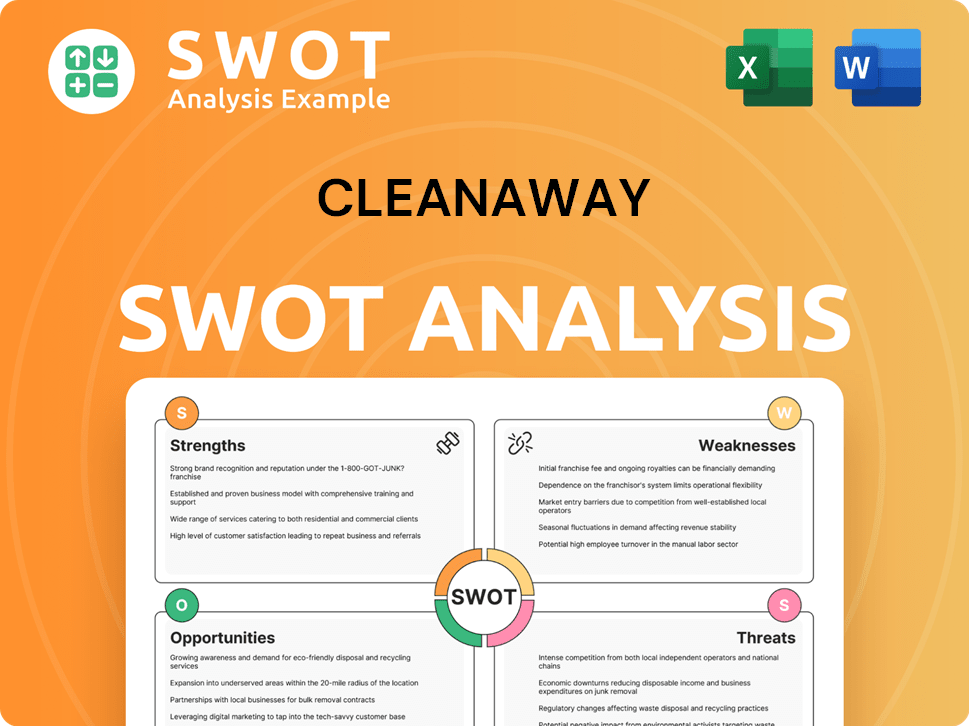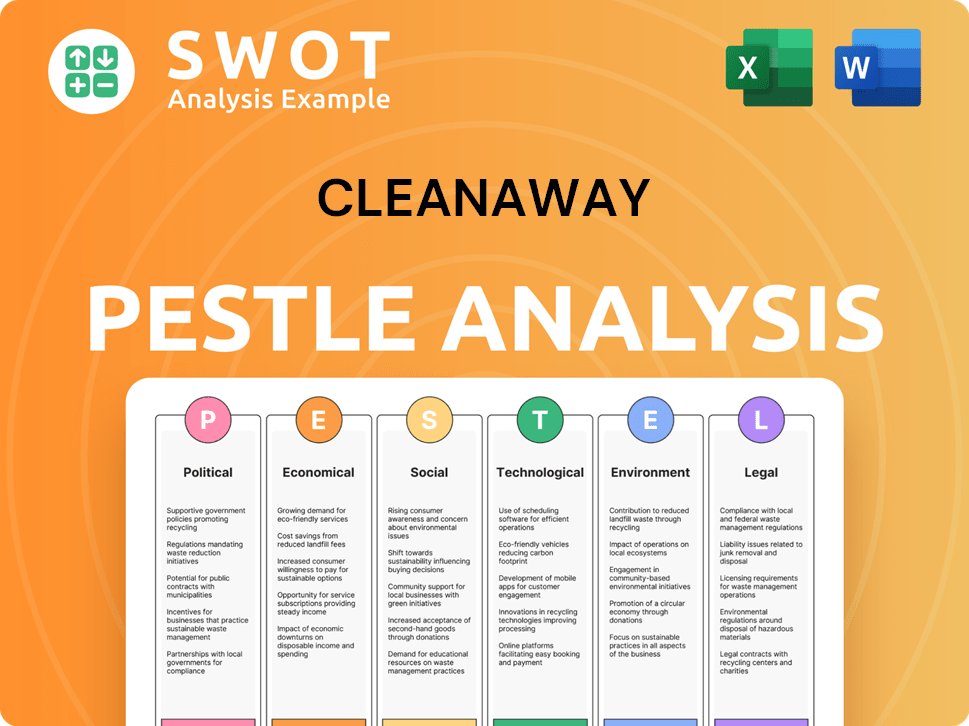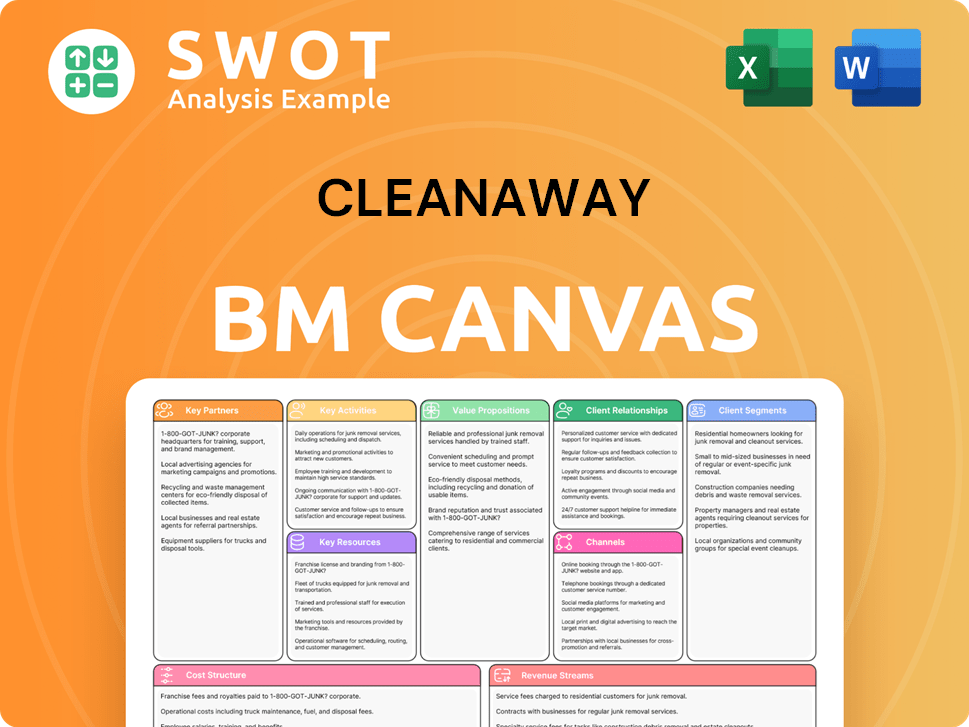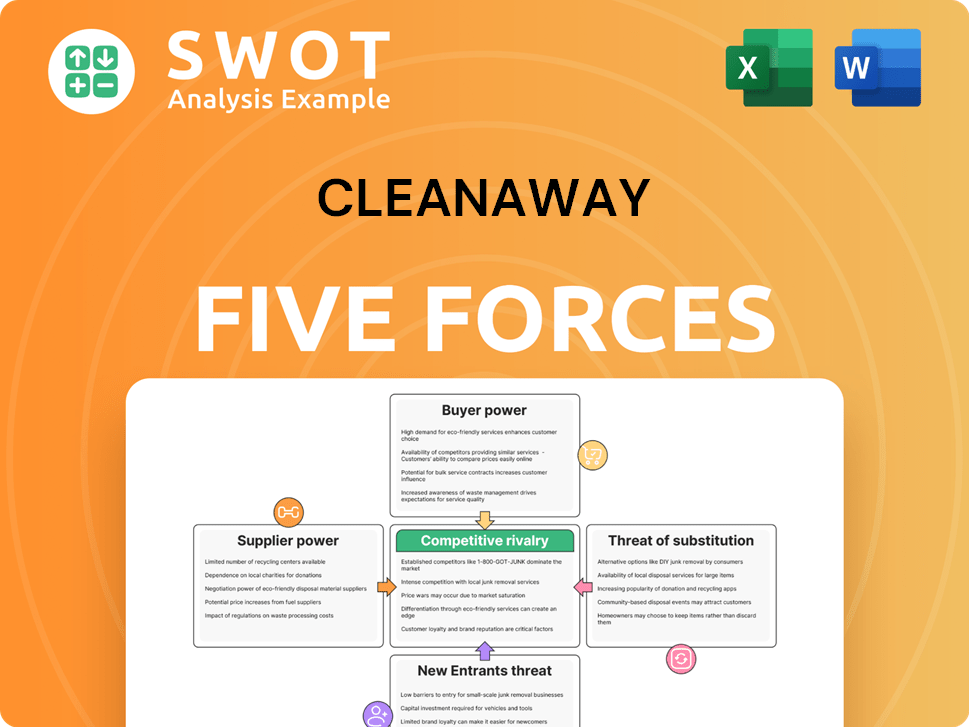Cleanaway Bundle
How Does Cleanaway Dominate the Australian Waste Management Scene?
The Australian waste management industry is in constant flux, shaped by stringent environmental regulations and a growing demand for sustainable practices. Cleanaway Waste Management Limited has risen to prominence, evolving from a small waste collector to the nation's leading waste management company. This transformation underscores Cleanaway's strategic prowess and operational excellence in a dynamic market.

Cleanaway's journey from a local operation to a national leader provides a compelling backdrop for a deep dive into its Cleanaway SWOT Analysis. This analysis will dissect the Cleanaway competitive landscape, examining its key Cleanaway competitors, and exploring the factors driving its success. Understanding the Cleanaway market analysis is crucial for anyone interested in the waste management industry and the broader environmental services sector, especially when evaluating waste disposal companies.
Where Does Cleanaway’ Stand in the Current Market?
Within the Australian waste management industry, Cleanaway Waste Management Limited maintains a leading market position. This is largely due to its extensive network and comprehensive service offerings. Cleanaway consistently ranks as a top-tier provider. The company's core operations involve solid waste collection, recycling, liquid waste services, and industrial and waste solutions. This caters to a diverse customer base, including municipal contracts, commercial enterprises, and industrial clients. For a detailed look at their target audience, consider reading about the Target Market of Cleanaway.
Cleanaway's value proposition centers on providing integrated waste management solutions. Their extensive geographic presence across all Australian states and territories gives them a significant competitive advantage. This national footprint enables them to serve various customer segments. Cleanaway has strategically shifted its focus toward resource recovery and sustainability, aligning with global trends. This involves significant investments in recycling infrastructure and advanced treatment technologies.
Financially, Cleanaway demonstrates robust health and scale. For the first half of the 2024 financial year, Cleanaway reported a net profit after tax of AUD 76.5 million and an earnings before interest, tax, depreciation, and amortisation (EBITDA) of AUD 358.5 million. This indicates strong operational performance. The company's scale and financial stability provide a solid foundation for continued investment in infrastructure and technology, reinforcing its market leadership.
While exact market share figures for 2024-2025 are subject to change, Cleanaway is often cited as the largest waste management company in Australia. This position reflects its extensive operations and comprehensive services. The company's strong presence in metropolitan and regional areas further solidifies its market position.
Cleanaway's competitive advantages include its broad range of services and national footprint. The company offers solid waste collection, recycling, liquid waste services, and industrial solutions. Its extensive infrastructure and long-standing relationships with councils and businesses contribute to its market strength.
Cleanaway's financial health is robust, as demonstrated by its 2024 financial results. The company's EBITDA of AUD 358.5 million and net profit after tax of AUD 76.5 million highlight its strong operational performance. This financial stability allows for continued investment in infrastructure and technology.
Cleanaway operates across all Australian states and territories, providing broad market coverage. This extensive geographic presence allows the company to serve a wide range of customers. Their established infrastructure in metropolitan and regional areas gives them a strong competitive edge.
Cleanaway's strengths include its market leadership, comprehensive service offerings, and national presence. Weaknesses may include the challenges associated with managing large-scale operations and adapting to evolving environmental regulations. The company's financial performance supports its ability to navigate these challenges.
- Market Leadership: Cleanaway holds a leading position in the waste management industry.
- Comprehensive Services: The company offers a wide range of waste management solutions.
- National Footprint: Cleanaway operates across all Australian states and territories.
- Financial Stability: Strong financial results provide a solid foundation for investment.
Cleanaway SWOT Analysis
- Complete SWOT Breakdown
- Fully Customizable
- Editable in Excel & Word
- Professional Formatting
- Investor-Ready Format

Who Are the Main Competitors Challenging Cleanaway?
The Owners & Shareholders of Cleanaway company operates within a dynamic and competitive Australian waste management industry. The Cleanaway competitive landscape is shaped by a mix of large multinational corporations, regional players, and emerging businesses. Understanding these competitors is crucial for analyzing Cleanaway's market position and strategic direction.
Cleanaway's market analysis reveals that the company faces challenges from both direct and indirect competitors. Direct competitors offer similar services, while indirect competitors provide alternative solutions or operate in related segments. This competitive environment influences pricing strategies, service offerings, and the adoption of new technologies.
Cleanaway's main rivals include Veolia Environment S.A., Suez Recycling & Recovery, and Remondis Australia. These companies possess significant resources and global expertise. They often compete for large-scale contracts and invest in advanced technologies.
Veolia is a global leader in environmental services, offering integrated waste management solutions, water management, and energy services. They compete with Cleanaway for municipal and industrial contracts.
Suez provides comprehensive waste collection, processing, and resource recovery services, with a focus on circular economy solutions. They compete directly in the waste management industry.
Remondis is a strong competitor, particularly in commercial and industrial waste services and resource recovery. They often compete on price and specialized offerings.
Numerous smaller, regional waste disposal companies compete with Cleanaway, often leveraging strong local relationships and niche services.
Indirect competition comes from companies offering alternative waste treatment solutions, such as waste-to-energy plants or advanced material recovery facilities.
New or emerging players, particularly those focused on specialized recycling technologies or digital platforms, could disrupt the traditional competitive landscape.
These competitors challenge Cleanaway through various strategies. These include aggressive bidding, investment in advanced recycling technologies, and expanding service portfolios. For example, in 2024, the waste management industry saw increased focus on sustainability and circular economy solutions, influencing how companies compete for contracts. The competitive landscape is also shaped by mergers and acquisitions, which lead to consolidation and shifts in market power. Recent data indicates that the waste management industry in Australia is valued at approximately $14 billion, with Cleanaway holding a significant market share. The company's financial performance, compared to its competitors, is a key factor in understanding its competitive advantages and future growth strategies. Cleanaway's focus on technological innovations, such as advanced waste sorting and processing, also plays a crucial role in its competitive positioning.
Several factors influence the competitive dynamics within the waste management industry.
- Pricing: Competitive pricing strategies are essential for winning contracts.
- Service Quality: High-quality service delivery is crucial for customer retention.
- Sustainability: Commitment to environmental sustainability is a key differentiator.
- Technological Innovation: Adoption of advanced technologies improves efficiency.
- Geographical Presence: Extensive coverage allows for a wider market reach.
- Customer Base: Targeting specific customer segments influences market strategies.
Cleanaway PESTLE Analysis
- Covers All 6 PESTLE Categories
- No Research Needed – Save Hours of Work
- Built by Experts, Trusted by Consultants
- Instant Download, Ready to Use
- 100% Editable, Fully Customizable

What Gives Cleanaway a Competitive Edge Over Its Rivals?
Understanding the Cleanaway competitive landscape involves assessing its key strengths and how it positions itself within the waste management industry. The company has built a strong foundation through strategic investments and operational efficiencies. A deep dive into its competitive advantages reveals a multifaceted approach to maintaining its market position, especially in a sector that is constantly evolving due to environmental regulations and technological advancements.
Cleanaway's success is significantly tied to its ability to offer comprehensive waste management solutions. This includes everything from collection and recycling to treatment and disposal, all under one umbrella. This integrated approach allows for greater control over the waste value chain, which is a critical factor in its competitive strategy. The company's focus on innovation, particularly in resource recovery and hazardous waste treatment, further strengthens its market position.
The company's extensive national network and infrastructure are crucial components of its competitive edge. This network includes a vast fleet of collection vehicles, transfer stations, recycling facilities, landfills, and liquid waste treatment plants across Australia. This comprehensive infrastructure enables Cleanaway to provide end-to-end waste management solutions, which many smaller waste disposal companies cannot replicate. This scale provides economies of scale and operational efficiencies, which are essential for profitability in the environmental services sector.
Cleanaway boasts an extensive network including collection vehicles, transfer stations, and recycling facilities. This infrastructure supports comprehensive waste management solutions nationwide. This expansive reach allows for efficient service delivery and cost management, setting it apart from smaller competitors.
The company's integrated model covers collection, recycling, treatment, and disposal, enhancing efficiency. This integrated approach allows for greater control over the entire waste value chain, leading to customized solutions. This model enables Cleanaway to offer a one-stop-shop for waste management needs.
Cleanaway invests in proprietary technologies, particularly in resource recovery and hazardous waste treatment. These innovations drive sustainability and align with market demands. The company's commitment to converting waste into resources is a key differentiator.
Cleanaway benefits from strong brand equity and long-standing customer relationships. These relationships, built over decades, foster customer loyalty and provide a stable revenue base. Long-term contracts with municipal, commercial, and industrial customers contribute to financial stability.
Cleanaway's competitive advantages are substantial, stemming from its operational scale, integrated services, and strategic investments. These strengths have evolved from traditional waste disposal to a model that emphasizes resource recovery and environmental sustainability. However, these advantages face threats from technological advancements by competitors and potential shifts in regulatory frameworks.
- Extensive Infrastructure: A vast network of facilities and vehicles enables comprehensive waste management solutions.
- Integrated Services: Offers end-to-end solutions, enhancing efficiency and customer service.
- Technological Innovation: Focus on resource recovery and hazardous waste treatment.
- Strong Customer Relationships: Long-standing relationships with a diverse customer base.
For further insights into Cleanaway's strategic moves, you can explore the Growth Strategy of Cleanaway. This can provide a deeper understanding of how the company is positioning itself for future growth and maintaining its competitive edge.
Cleanaway Business Model Canvas
- Complete 9-Block Business Model Canvas
- Effortlessly Communicate Your Business Strategy
- Investor-Ready BMC Format
- 100% Editable and Customizable
- Clear and Structured Layout

What Industry Trends Are Reshaping Cleanaway’s Competitive Landscape?
The Australian waste management industry is undergoing significant transformation, driven by a shift towards a circular economy and stringent environmental regulations. This dynamic environment presents both challenges and opportunities for companies like Cleanaway. A thorough Cleanaway market analysis reveals the need for strategic adaptation to remain competitive. The industry's future depends on embracing sustainable practices and technological advancements.
The competitive landscape is evolving, with increased emphasis on resource recovery and recycling. This shift necessitates considerable investment in infrastructure and technology. Companies must navigate volatile commodity prices and potentially face new market entrants. Understanding the Cleanaway competitive landscape is crucial for strategic planning and sustainable growth.
The waste management industry is seeing a rise in the circular economy model, which emphasizes resource recovery and waste minimization. Regulatory changes, such as stricter landfill levies and bans on certain waste types, are pushing companies to innovate. Technological advancements, including automation and data analytics, are reshaping operational efficiencies.
Managing the increasing complexity of waste streams is a key challenge. Navigating volatile commodity prices for recycled materials and potential new market entrants specializing in sustainable technologies pose difficulties. Declining demand for traditional landfill services and increased competition in resource recovery could impact profitability.
Emerging markets in specialized waste treatment, such as hazardous waste or e-waste, offer growth potential. Innovations in product design that facilitate easier recycling and strategic partnerships for closed-loop systems present avenues for expansion. Leveraging existing infrastructure to offer new value-added services is also a key opportunity.
The competitive position will likely evolve towards a resource-centric model. This involves continued investment in recycling and recovery infrastructure. Expanding the service portfolio to meet circular economy demands is essential. Leveraging scale and national presence will be crucial for resilience in a dynamic market. Learn more about how Cleanaway operates by reading Revenue Streams & Business Model of Cleanaway.
The Cleanaway competitive landscape is shaped by several key factors, including market share, service offerings, and technological innovation. Understanding these factors is crucial for assessing the company's position and future prospects. The company's success depends on adapting to market changes and maintaining a strong competitive edge.
- Market Share: Cleanaway holds a significant market share in the Australian waste management industry.
- Service Offerings: Cleanaway offers a wide range of services, including collection, processing, and disposal.
- Technological Innovation: Investment in advanced recycling technologies and waste-to-energy solutions is critical.
- Sustainability Initiatives: Commitment to environmental sustainability and circular economy principles is increasingly important.
Cleanaway Porter's Five Forces Analysis
- Covers All 5 Competitive Forces in Detail
- Structured for Consultants, Students, and Founders
- 100% Editable in Microsoft Word & Excel
- Instant Digital Download – Use Immediately
- Compatible with Mac & PC – Fully Unlocked

Related Blogs
- What are Mission Vision & Core Values of Cleanaway Company?
- What is Growth Strategy and Future Prospects of Cleanaway Company?
- How Does Cleanaway Company Work?
- What is Sales and Marketing Strategy of Cleanaway Company?
- What is Brief History of Cleanaway Company?
- Who Owns Cleanaway Company?
- What is Customer Demographics and Target Market of Cleanaway Company?
Disclaimer
All information, articles, and product details provided on this website are for general informational and educational purposes only. We do not claim any ownership over, nor do we intend to infringe upon, any trademarks, copyrights, logos, brand names, or other intellectual property mentioned or depicted on this site. Such intellectual property remains the property of its respective owners, and any references here are made solely for identification or informational purposes, without implying any affiliation, endorsement, or partnership.
We make no representations or warranties, express or implied, regarding the accuracy, completeness, or suitability of any content or products presented. Nothing on this website should be construed as legal, tax, investment, financial, medical, or other professional advice. In addition, no part of this site—including articles or product references—constitutes a solicitation, recommendation, endorsement, advertisement, or offer to buy or sell any securities, franchises, or other financial instruments, particularly in jurisdictions where such activity would be unlawful.
All content is of a general nature and may not address the specific circumstances of any individual or entity. It is not a substitute for professional advice or services. Any actions you take based on the information provided here are strictly at your own risk. You accept full responsibility for any decisions or outcomes arising from your use of this website and agree to release us from any liability in connection with your use of, or reliance upon, the content or products found herein.